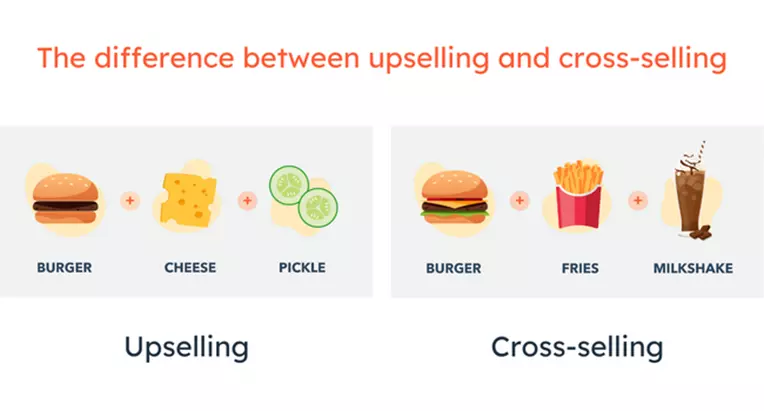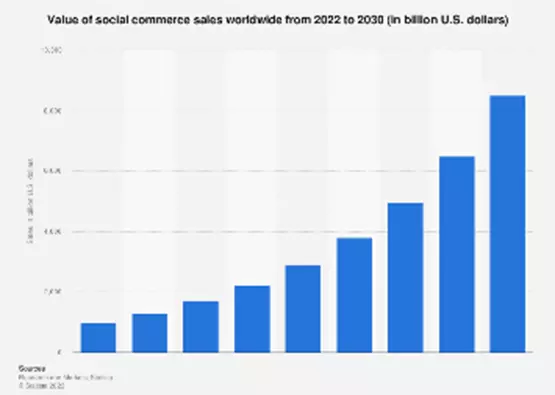Shoppable content has taken the Internet — and in particular social media sites — by storm in recent years. In fact, a study by Accenture projects that the social commerce industry will grow to $1.2 trillion by 2025, at a rate three times faster than traditional ecommerce channels.
This hasn’t just prompted brands to rethink their content marketing strategies; it has driven a cultural shift in how people engage with products and adverts. Its popularity with younger generations is especially apparent, and the trend is only set to continue in coming years.
Luckily, we’ve put together this short but comprehensive guide that will explain everything you need to know about shoppable content. We’ll cover why it’s so effective at driving conversions, as well as the best methods you can use when getting started. Let’s dive in!
What is Shoppable Content?
Shoppable content is an advertising format that makes it easier for customers to buy products that they see online. Like regular adverts, a piece of shoppable content typically includes a picture of the product and a short piece of accompanying text.
What sets it apart is the inclusion of shoppable elements — which, when clicked on, provide customers with instant access to shopping features. This simplifies the purchase process to a few minor steps:
You see a product > You click on the advert > You can instantly order it via digital checkout
As such, shoppable content exists at the intersection of information and commerce; a new content format only made possible with the development of interactive web pages.
Despite shoppable content being a relatively new concept, it has quickly become entrenched as an important marketing strategy for businesses of all sizes. It’s common to see small-scale drop shippers build an entire business model around shoppable content, as well as big-name brands adopting the alternate conversion path as part of their enterprise transformation.

6 Reasons Why Shoppable Content is so Effective
This section explores the key benefits of shoppable content and how it differs from traditional ecommerce strategies.
It’s More Engaging
Shoppable posts can be much more engaging than other pieces of content because of the instant gratification involved. They usually advertise visually aesthetic products that catch your eye as you’re scrolling through a social media feed. Then, it’s just a case of scratching that itch and buying the product for yourself.
There’s an element of psychology at play here — that when online shoppers see products next to posts from their family and friends or their favorite groups, then they’ll come to associate that product with positive experiences.
It Shows “Social Proof”
On social media sites, shoppable content helps to build consumer trust and positive public perceptions of your products. That’s because social networks are public forums where people can leave their honest opinions for everyone else to see. So, if a post has lots of likes, shares, and positive comments, then it proves that your brand is trustworthy and your products are worth buying.
It Provides a Seamless Shopping Experience
Shoppable content typically enjoys a higher conversion rate than other ecommerce channels. The reason for this is simple — because it removes many of the steps involved in traditional purchase decisions.
When a customer clicks on a shoppable content post, they’ve unlocked a direct purchasing opportunity. They have less time to reconsider their choice, they’ll just pay for the item and go back to scrolling on their social feeds. You simply don’t get this convenience when you have to create an account on an ecommerce website, for example.

It Encourages User-Generated Content
When customers see your products on their social feed, they’re more likely to post about it themselves. Whether they leave a review in the Comments section or record their own unboxing video — this type of ‘natural marketing’ is perfect for building brand trust and awareness. Make sure to encourage it by setting up an affiliate marketing program, as that will incentivize people to drive conversions via their posts.
You may want to set up contact center integrations with your shoppable content pages, as it’ll be easier to communicate with your network of affiliates and foster a sense of brand loyalty. With a brand listening strategy, you could even reach out directly to top fans on social media and propose that you feature their glowing customer reviews in your next advert.
It Opens up New Data Sources
Shoppable content opens a new world of data analysis for brands to hone their customer acquisition strategy. For example, with platforms like Instagram insights, you can see which demographics your products are most popular with, such as your average customer’s age, gender, and interests. From here, you can implement a targeted marketing strategy that focuses on this customer persona.
It’s also easy to implement A/B testing, which is when you release two adverts with one slight difference. You compare the performance of each, and stick with the one that drives the most conversions. As you rinse and repeat this cycle, you’ll move toward a benchmark of highly engaging shoppable posts.
Another good strategy is to monitor the activity of rival brands and see what marketing tactics you can borrow from them. For instance, you could target competitor keywords as part of your campaign to end up ranking higher in search engine result pages. That’s especially useful for social media sites, since people’s attention spans are so low that they’ll often just click on the first result that comes up.
It Creates More Opportunities for Conversions
Finally, shoppable content allows you to build a more focused sales journey in the customer context.
You can set up your posts to be displayed in a specific order depending on audience choices. So, if someone has previously bought one of your products, then you might cross-sell a complimentary item to go with it. Likewise, you could implement an up-selling strategy for a ‘premium’ version of a product if your post was ignored the first time around.

What are the Main Types of Shoppable Content?
In this section, we’ll explore some of the most common types of shoppable content that you may want to get started with:
Shoppable Social Media
The most popular approach to shoppable content is to sell products and services through posts on social networks — a practice referred to as “social commerce”. It’s easy to see why, as social media is the perfect platform for reaching billions of people around the world and generating widespread brand awareness.
It’s also pretty easy to set up, with most social media platforms having integrated shopping features available for business accounts. Once you’ve designed your shoppable content image and text, all you need to do is create a new post, select the “Tag Products” option, and choose the products from your catalog that are featured in the post.
Popular platforms like TikTok shopping and Instagram shopping allow you to target specific audiences based on factors like their age, gender, interests, or app behavior. Try running a few different campaigns and seeing what forms of content appeal to each demographic, and you’ll have an effective formula for driving conversions in no time.
The best part is that you don’t even need to set up anything too technical, as features like shopping carts and payment processing are handled entirely by the social platform. However, the catch is that they’ll often charge you a flat rate or fee on each purchase, usually totaling around 5% of each transaction.
An alternative approach is to use shoppable content ads on social media that direct potential customers to that specific product listing on your website. This circumvents the social media’s universal checkout and means they don’t take a cut of your sale. Just remember to set up your campaigns so localized content directs customers to the correct version of your website — directing French-language posts to a .fr domain, or Arabic-language posts to Qatar domains, for example.

Shoppable Videos
Some brands also use interactive videos that allow the viewer to directly click on-screen elements and purchase the featured product. It’s a bit more technical than a static image, as your product tags will need to move with the product itself.
However, it’s a great approach simply because of how engaging it is: customers get to see the products in action and would have an instant desire to learn more.
Shoppable Blog Posts
Shoppable blog posts integrate e-commerce features into traditional blog content. For example, a page explaining a product’s use-case or unique selling point could include a clickable call-to-action that adds the item to your basket. This could work especially well with a limited-time promotion or special offer that you unlock for reading the article.
Shoppable Photography
Shoppable content thrives on visual appeal — it’s the products that are the most eye-catching that will drive the most conversions. As such, shoppable galleries are a popular way of presenting multiple varieties of a product. Users can navigate through the images and click on the one that they like the most, taking them straight to a page on buying options.
You could also include a visible image source or product credits as a way of informing customers about the products featured and where to find them.

Shoppable Content: The Future of Commerce?
The immense popularity of content platforms and social media has catapulted shoppable content into our everyday lives. But how does it stack up against other ecommerce strategies, and is it worthwhile for established brands to expand into? To answer that question, you need to ask yourself about the sort of products that you want to sell:
Generally, shoppable posts work best when they’re advertising products that are affordable, have broad public appeal, and are easy to understand conceptually. The idea is to drive ‘impulse buys’, meaning the strategy won’t work as well with niche products that require a higher level of customer decision-making.
So, while shoppable content is certainly a lucrative business model for some products, it certainly won’t replace the ecommerce industry in its entirety. The best way to think of it is as a highly targeted type of marketing strategy — one that will be a no-brainer for some businesses, but ineffective for others.








